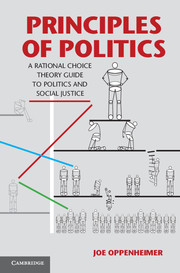Book contents
- Frontmatter
- Contents
- Propositions and Corollaries
- Tables
- Figures
- Sidebars
- Definitions
- Preface
- Overview of the Book
- Acknowledgments
- Introduction: Politics, Universals, Knowledge Claims, and Methods
- Part I The Logic of Collective Action
- Part II Collective Choice
- Part III Political Institutions and Quality Outcomes
- Part IV Social Justice, Choice, and Welfare
- Bibliography
- Name Index
- Subject Index
Part IV - Social Justice, Choice, and Welfare
Published online by Cambridge University Press: 05 August 2012
- Frontmatter
- Contents
- Propositions and Corollaries
- Tables
- Figures
- Sidebars
- Definitions
- Preface
- Overview of the Book
- Acknowledgments
- Introduction: Politics, Universals, Knowledge Claims, and Methods
- Part I The Logic of Collective Action
- Part II Collective Choice
- Part III Political Institutions and Quality Outcomes
- Part IV Social Justice, Choice, and Welfare
- Bibliography
- Name Index
- Subject Index
Summary
Social Justice, Choice, and Welfare
The many hurdles identified in earlier sections of this volume project a tone of pessimism regarding politics. Without formal political institutions, collective interests are unlikely to be properly addressed. But even with formal institutions, given the manipulations, preference cycles (as discussed in Chapter 5), and more, the achievement of collective interests, appears always threatened. Now it is time to clarify “collective interests.” One objective of political analysis is to identify the relationship between social choice and social well-being (or as it is commonly called, social welfare). To this point, all we have identified are some difficulties in this relation. We have some positive work to do.
What are collective interests? As we will find in Chapter 8, in trying to conceptualize collective interests, one runs into severe problems. Is this only because preference cycles make interpretation of results difficult? Can this be avoided by bypassing majority rule? Although we may desire to design institutions to help us hit the target of social well-being, Kenneth Arrow (1963), has shown there will be no easy method to even identify the target. If, as many economists think, individual wellbeing is to be conceptualized as the satisfaction of one’s preferences, and social welfare is to be understood as the aggregation of individual well-being, Arrow identifies enormous roadblocks to any easy understanding of social welfare. His argument is the main focus of the first part of Chapter 8.
- Type
- Chapter
- Information
- Principles of PoliticsA Rational Choice Theory Guide to Politics and Social Justice, pp. 185 - 192Publisher: Cambridge University PressPrint publication year: 2012



